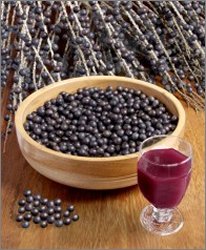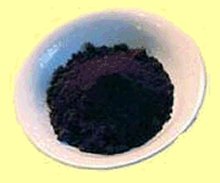The Largely Unknown Berry that is Ranked #1 in Antioxidant Value of Any Known Food
by www.SixWise.com
Açaí berries, dark-blue fruits from the Açaí
palm tree, have been gaining attention as a functional "superfood"
and antioxidant powerhouse since they hit the market in 2000.
|

Açaí berries (pronounced "ah-sigh-EE"),
found to have the highest antioxidant value of any food,
are being promoted for their potential energy-boosting,
health-enhancing effects.
|
The grape-like berries, native to tropical Central and South
America, have long been a staple food, mixed with tapioca
or sugar, of Brazilian Amazon peasants, but the tropical-tasting
fruits (with chocolate-flavored undertones) are now being
studied worldwide for their potential health benefits.
The Highest Antioxidant Values of Any Food
Two articles in the Journal of Agricultural and Food Chemistry
examined the antioxidant activity of freeze-dried açai
fruit pulp/skin powder, which researchers named "OptiAcai."
The berries have a high level of anthocyanins, compounds
that give the berries (as well as grapes and other dark-colored
berries) their color and high antioxidant levels.
The studies found that OptiAcai had the highest antioxidant
levels of any food, as
measured by the oxygen radical absorbance capacity (ORAC),
the scale used to measure antioxidant activity.
Antioxidants are so important because they protect your cells
from free radicals. Similar to rust on a car, free radicals
can cause oxidation
in your body that may lead to disease and aging. The American
Dietetic Association points out that antioxidants can help
to not only prevent oxidation but also to support your immune
system and decrease your risk of:
-
Infection
-
Heart disease
-
Cancer
However, not all açai products hold this potential
antioxidant benefit.
"What mystifies me is that the açai products
we tested in the commercial marketplace had a fraction of
the antioxidant activity reported in our paper for OptiAcai
... in our paper we report that the highest Total ORAC
we found was 155 for any freeze-dried sample, compared to
the 1026.9 for OptiAcai. USDA and Brunswick Laboratories confirmed
the unusually high ORAC," said lead researcher Alex Schauss.
|

Be wary of açai products on the market. Researchers
found much lower antioxidant levels in them, possibly
because of differences in drying and shipping methods
of the highly perishable berries.
|
Manufacturing Process May Affect Antioxidant Value
When the researchers tested açai products on the market,
none came even close to the antioxidant values found in OptiAcai.
Because açai berries are highly perishable, the researchers
believe the lower values may have to do with how the fruit
is dried and shipped.
"We believe there are many reasons for the lower ORAC
values of various açai's that have been on the market
for some time. First, freeze-drying is superior to spray drying
or air drying in retaining phytochemicals and nutrients, but
more expensive," Schauss said.
"We believe that other suppliers have not considered
the issue of enzymatic degradation of the fruit. We systematically
studied this issue years ago to determine when to process
the fruit into a powder. This was all done in Brazil.
"Much of what is being shipped out of Brazil comes to
the USA or Europe in container-sized frozen blocks. This does
not prevent the continuous degradation of the polyphenolics.
Hence, this would explain why we obtained such low Total ORAC
units for frozen açai samples," he said.
Açai Kills Cancer Cells in Lab
Adding to açai berries' allure, another study in the
Journal of Agricultural and Food Chemistry found that extracts
of the fruit caused up to 86 percent of leukemia cells tested
in a lab to self-destruct.
"Açai berries are already considered one of the
richest fruit sources of antioxidants," said Stephen
Talcott, an assistant professor with the University of Florida's
Institute of Food and Agricultural Sciences. "This study
was an important step toward learning what people may gain
from using beverages, dietary supplements or other products
made with the berries."
|

Looking for other antioxidant-rich foods? Blueberries,
blackberries, pecans and kidney beans are all excellent
choices.
|
While the findings do not prove that compounds in açai
berries may prevent leukemia in people, the researchers were
optimistic.
"This was only a cell-culture model and we don't want
to give anyone false hope," Talcott said. "We are
encouraged by the findings, however. Compounds that show good
activity against cancer cells in a model system are most likely
to have beneficial effects in our bodies."
Other Very Top Antioxidant Foods
While açai continues to be studied, and until you
can be sure that the berries you're buying contain beneficial
amounts of antioxidants, you can fortify your diet with these
other top antioxidant foods, based on a 2004 study in the
Journal of Agricultural and Food Chemistry.
- Small red beans (dried)
- Wild blueberries
- Red Kidney beans
- Pinto beans
- Blueberries (cultivated)
- Cranberries
- Artichokes (cooked)
- Blackberries
- Prunes
- Raspberries
- Strawberries
- Red Delicious apples
- Granny Smith apples
- Pecans
- Sweet cherries
- Black plums
- Russet potatoes (cooked)
- Black beans (dried)
- Plums
- Gala apples
Recommended Reading
Six
Disease-Fighting Super Antioxidants You are Likely Not Getting
Enough Of
The
Remarkable Antioxidant Power of Cranberries -- and Three No-Cost
Cranberry Recipes
Sources
Journal
of Agricultural and Food Chemistry. 2006 Nov 1;54(22):8604-8610.
Journal
of Agricultural and Food Chemistry. 2006 Nov 1;54(22):8598-8603.
FoodNavigator.com
November 8, 2006
Natural
Products Industry Insider
University
of Florida News